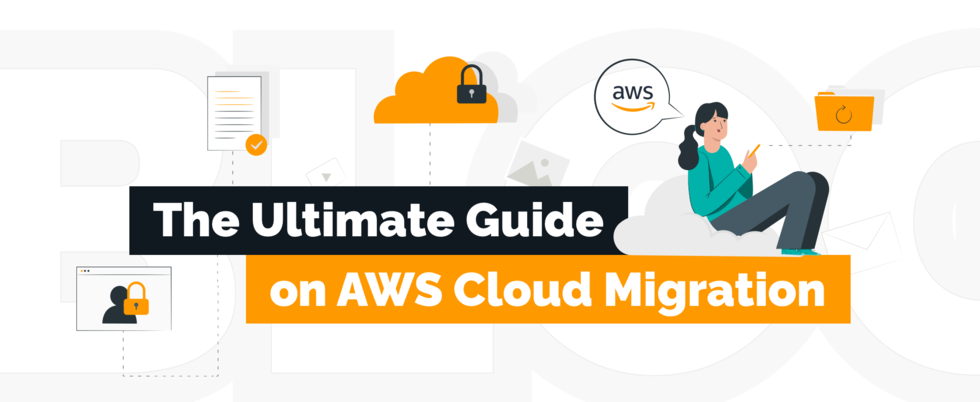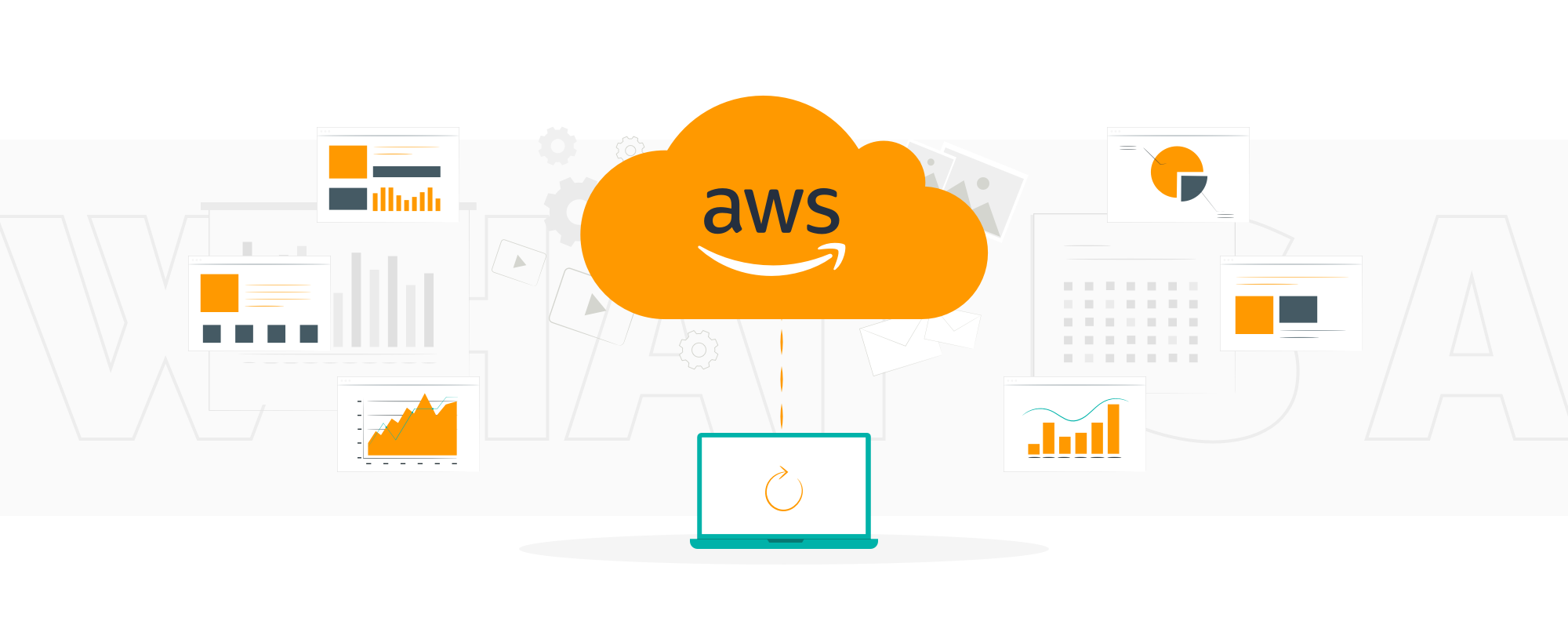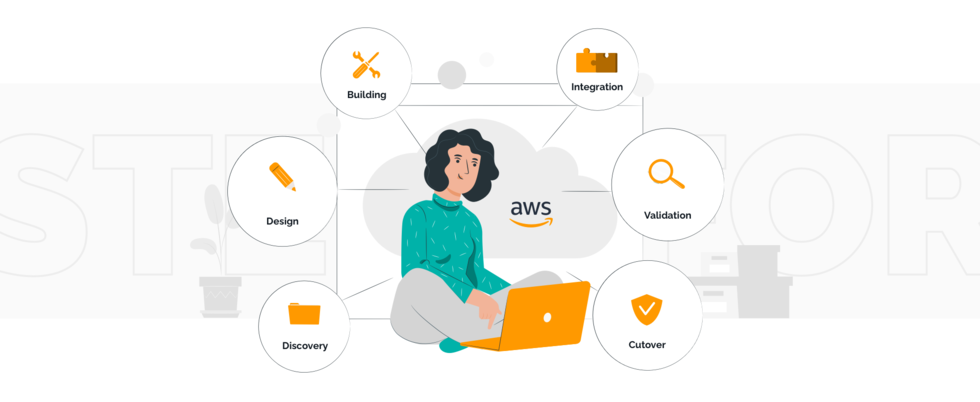How to Migrate to AWS Cloud: Tools & Strategy for Migration


Learn about AWS cloud migration and its benefits. Discover the best tools and strategies for a successful migration in a step-by-step guide.
The AWS cloud platform helps businesses modernize the IT asset base with a cost-effective, secure, and elastic infrastructure. Nonetheless, migrating existing applications to the AWS cloud can be a challenge. You need to have a plan, strategy, and the right tools to make the transfer smoother.
Now for the good news: we know the tools, methodologies, and suitable strategies to help you transition to the AWS cloud. The process might be complex, but we’ll guide you through it step-by-step.
What is AWS cloud migration?

AWS (Amazon Web Services) is the world's most popular IaaS (Infrastructure as a Service) cloud platform. According to Gartner's 2020 Report, Amazon's service is the undisputed leader among IaaS cloud providers. And it’s not just the biggest cloud system: AWS has been retaining the leading position for ten consecutive years.
Now, AWS cloud migration means transferring data from your hosting facility (on-premise environment, private or public cloud) to Amazon's cloud infrastructure.
You can move:
- Databases
- Websites
- Applications
- Physical storages
- Virtual servers
- Data centers
Companies are moving to AWS from an on-premise environment for a reason. And there are several factors that make them opt for the AWS platform.
Why should you migrate to AWS cloud?
According to Gartner's 2019 research, the revenue from cloud services will grow from $227 billion in 2019 to $354 billion in 2022. In other words, the market for cloud services has long become mainstream.
The best part? AWS has the lion's share of the cloud market. Its benefits include:
- Sustainability. AWS’s infrastructure is about 3.6 times more energy-efficient compared to regular data centers, according to the 2019 Study by 451 Research.
- Value. IDC's 2018 Report shows that companies spend 31% less on infrastructure with AWS than with similarly sized on-premise ones.
- Management. Amazon's services come with various tools and templates for workflow optimization, improving the IT management capabilities by up to 62% compared to a regular environment.
- Server capacity. Amazon has the largest server network among IaaS vendors. As a result, it offers 99.99% uptime and low application latency.
- Security. AWS is backed by innovative security tools. Based on the previously mentioned IDC Report, Amazon's IaaS can reduce 43% of breaches and other security events for an average company.
The vast server network and scalable infrastructure make cloud migration to AWS the best option for many organizations. Startups, SMBs, and larger enterprises can optimize their workflows and decrease security risks while spending less money. But first, you'll need to plan how to transfer your workload.
What to consider for AWS cloud migration: Pre-planning & strategy
Are you wondering how to migrate applications to AWS? Migrating to AWS cloud involves multiple phases. Start by creating a detailed project plan for transferring your existing data, applications, and workloads.
What should you do to outline your strategy?

Identify resources and responsibilities
The pre-planning stage starts with identifying your budget, scope, and schedule. Some of the things you should outline during this phase include:
- Key resources for migration work streams
- People and departments responsible for each resource
- Size of transferable items (databases, data centers, applications)
- Migration phases (stages)
- Timeline for each step of the migration
- Risk and mitigation logs (including data backup tools)
You can facilitate the process by creating a RACI (Responsible, Accountable, Consulted, and Informed) chart. This chart will help you assign roles to specific stakeholders and define their responsibilities during migration.
Outline migration teams
Successful migration often has two types of responsible migration teams:
- Migration Factory teams. These help to execute the migration plan and transfer applications. They also automate repeated patterns and low-complexity operations to make the whole process faster. Usually, companies have multiple migration factory teams that work concurrently on different types of applications.
- Core Cloud teams. These are more of a central hub to manage your project and share insights among migration teams. The Core Cloud teams help coordinate resources, assess risks, develop automation solutions, and optimize backlogs. The team should also form a Cloud Center of Excellence (CCoE) for accumulating best practices, standards, and automation tools.
How do you make collaboration effective with so many teams? We recommend creating a communication plan that outlines change management, reporting, escalation procedures, and communication tools. Usually, the Core Cloud team will drive communications during the AWS migration.
Define the project management methodology
A management methodology is a set of tools designed to help you streamline your AWS cloud migration project. Transferring workloads to the cloud requires a clearly defined and practical approach. But don’t worry: AWS has made sure you won't have to reinvent the wheel.
AWS Prescriptive Guidance contains proven approaches and patterns to accelerate your migration to the cloud. You can use it as a template for your AWS cloud migration plan.
Assess the readiness for cloud operations
This is the fundamental part of the migration process that consists of financial and technical planning.
- Financial planning involves a detailed analysis of the costs for transferring workloads to AWS. The expenses include the costs to migrate the targeted environment to the cloud. You should also account for server, storage, and network costs.
- Technical planning is the deep evaluation of your application's architectures. If you want to be agile, your team should build a backlog and determine which apps and data to transfer first. Moreover, you must consider the possible security risks and identify the critical assets that are better kept off the cloud.
We recommend dedicating a small team to gather information about your current architecture. These teams should organize applications in your environment into patterns to determine the costs and timelines for each.
The scale of the migration project can be overwhelming. It would help to adopt the iterative methodology, which means prioritizing applications and moving several apps to the cloud simultaneously in sprints.
The progress can be slow and expensive at first, but your teams will get more proficient as you proceed with the migration. In any case, it’s usually more effective to turn to professionals with relevant experience that work according to proven methodologies.
Interested to learn more about our AWS expertise?
Learn moreFind an experienced cloud partner
A skilled AWS partner can guide you through the migration process, making it faster, smoother, and, ultimately, cheaper.
Remember that you'll be entrusting this company with your business data, so your decision should be deliberate and informed. Here's what you should look out for in a migration vendor:
- Data safety. Professional companies can guarantee the security of your information. Needless to say, an NDA (non-disclosure agreement) should be a must.
- Experience. Make sure your vendor has relevant expertise if you want to avoid the widespread AWS cloud migration issues.
- Pricing. The migration procedure may be costly, but the right vendor can reduce your expenses with a practical framework.
- Certification. When you're dealing with AWS Migration Consulting Partners, you can be sure they’re experts with deep technical expertise.
You’re welcome to migrate databases, applications, storage, and servers on your own. But your success rate will increase exponentially if you decide to work with a professional cloud computing service provider.
Planning AWS cloud migration
Once the preparations are over, you should move to the planning phase. Your primary objective here is to review tools and management methods to streamline the migration.
AWS migration tools
Cloud migration is a complex process, but middleware software can help you migrate applications and databases to the AWS cloud with the least effort.
Some valuable tools for AWS migration are:
- Migration Evaluator (formerly known as TSO Logic). A tool for analyzing data from an on-premise environment to help transfer applications and software to the cloud at the lowest cost of ownership.
- Cloud Adoption Readiness Tool (CART). A 16-question online survey that generates a report with a conclusion and recommendations on your readiness for AWS cloud migration
- AWS Migration Hub. A unified location where you can streamline, plan, and track app migrations.
- AWS Application Discovery Services. A useful app for AWS cloud migration planning that helps analyze on-premise servers (including configurations, processes, network connections, and resource usage) and calculate the cost before migration. This tool integrates with AWS Migration Hub to help you track the data transfer.
- AppDynamics. An intuitive platform for performance management that works with on-premise, SaaS, private, and hybrid environments and has several AWS monitoring features.
- AWS Server Migration Service (SMS). An agentless service that helps you automate, schedule, coordinate, and track replications of large workload volumes from on-premise locations to AWS cloud with minimal network bandwidth.
- AWS Database Migration Service (DMS). An intuitive service that helps to migrate data from the commonly used open-source and commercial databases to Amazon services.
- CloudEndure Migration. An automated tool that simplifies and reduces the cost of transferring apps, physical, virtual, and cloud servers to your AWS account.
These tools can accelerate the transfer process and reduce operating costs. In the right hands, they’ll be particularly helpful when you're exporting complex applications.
Cloud storage operations
Next, you need to consider cloud storage options based on the costs, response time, accessibility, and update consistency. The categories of AWS cloud storage include:
- File storage. Cloud storage with a file system that supports Network Attached Storage. It’s a perfect option for shared files, content repositories, and media stores. Amazon EFS (Elastic File System) and Amazon FSx for Windows File Server are good examples of file storage.
- Object storage. Scalable storage type made for app development. Object storage solutions like Amazon S3 (Simple Storage Service) and Amazon Glacier are secure and easy-to-use platforms for deep analysis and storage costs optimization.
- Block storage. Low-latency storage with virtual servers. Block storages like Amazon Elastic Block Store (EBS) are ideal for databases and enterprise resource planning (ERP) systems.
So, you have the plan, tools, and storage. The next step is setting up the foundation for the transfer.
Migration strategies
You need to outline a migration plan for each application in your portfolio to figure out what to prioritize. Sounds like a lot of work, doesn't it? That's true, but you can make the process easier by using the "6 R" framework:
- Rehost — for apps that can be transferred without changes
- Retire — for apps you no longer need (about 15% of the IT portfolio usually becomes irrelevant after moving to a cloud platform)
- Retain — critical business apps that need major reworking before transferring
- Repurchase — perpetual apps you can replace with SaaS solutions
- Replatform — apps requiring slight optimization to improve their effectiveness
- Refactor (Rearchitect) — the most expensive strategy for apps that need enhancement with cloud-native features
AWS migration consulting and well-designed migration strategy will align with your company's business goals and vision. Just remember that it should help your teams. So, you have to pick a strategy that supports your management methodology.
Application migration options
Lastly, let's examine the ways of application migration to AWS cloud. The most popular options are:
- Live migration refers to continuous data transfer without disconnecting the application
- AWS data migration means pushing data to the AWS cloud while keeping the file format and storage type
- VM conversion is about transforming virtual machine disk data with API (Application Programming Interface) to turn it into an AWS-compatible format
- App containerization involves OS tools for converting, deploying, and running distributed applicationsThese options differ not only in approaches but also in the level of effort. For example, live migration and VM conversion require the least time and resources, whereas App containerization requires in-depth planning and complex system configurations.
6 AWS cloud migration steps
Now, it’s time to get down to the actual migration process, which can roughly be split into six steps:
- Discovery
- Design
- Building
- Integration
- Validation
- Cutover
Let’s take a detailed look at each of them.

#1 Discovery
Your teams start by gathering info about the applications you prioritized for migration. There are two types of data here:
- Discover Business Information (project roadmap, operation runbooks, app owner, and planning backlog)
- Discover Technical Information (data flow, process data, connectivity, and server stats)
For apps that require optimization or restructuring, you’ll need to confirm the gathered data with the application owner and the Migration Factory team. Rehost apps (that can be moved without changes) are usually analyzed in groups of matching patterns.
#2 Design
Next, you need to develop a Target State document, which will include:
- AWS architecture
- Application architecture
- Supporting processes and components
The workflow usually depends on the Infrastructure Architecture document that outlines information about:
- AWS migration service and tools
- Foundational elements
- Data flow
- Resource consumption (external and internal)
- Monitoring design
You should’ve gathered this info during the pre-planning phase and the discovery step. The engineering and sprint teams will use this data to stage the design for the AWS environment.
#3 Building
During this step, migration teams move the app according to the approved design. You assign roles between stakeholders based on the necessary tools, templates, and other requirements. The teams will use the methodology, strategies, and software you’ve chosen during the pre-planning and planning phases.
#4 Integration
After the transfer, your team works with external service providers to connect the application to the AWS cloud. Furthermore, you’ll often have to work with consumers to test the functionality of each app. The team also has to assert basic validations against the AWS-hosted apps before moving to the next step.
#5 Validation
Prior to the release, the teams have to evaluate each application for:
- Functionality
- Performance baselines
- Build verification
- Business continuity
- Disaster recovery capability
You’ll have to verify release management, as well as the rollback plan (in case the AWS cloud migration was unsuccessful). Before moving to the next stage, your team has to run parallel testing for applications.
#6 Cutover
Perform the user acceptance test and identify if the migration was successful. In case of failure, you’ll have to roll the migration back according to the plan.The first few tries should give you an idea of how to proceed and which processes require optimization. But here’s the good part: you’ll save significant resources and time if you work with a certified AWS consulting partner who can help you pick the best frameworks, methodologies, and tools.
Interested to learn more about our AWS expertise?
Learn moreOur approach to AWS cloud migration
TechMagic is a JavaScript app development company that delivers fully serverless and hybrid architectures for various tech products. Among other things, we offer scalable and cost-efficient AWS cloud migration of your entire infrastructure.
We developed several SaaS platforms for international companies using AWS’s services. Just take a look at some of our projects:
Mobile Practice
Mobile Practice is a micro practice and coaching SaaS education platform. The client asked us to make the service optimized for video streaming in the US and EU. On top of that, the app had to overcome potential vendor lock.
We applied the serverless framework enhanced by AWS S3, Lambda, Firebase, and MongoDB. Amazon's microservices allowed us to deploy app modules separately and track the app performance to avoid critical issues. The result is a highly scalable and serverless product that can stream video without buffering issues for users globally.
Elements.cloud
Elements.cloud is a B2B SaaS management platform for companies needing to organize their business processes. The main challenge was to develop a highly customizable mapping process and tool for visualization.
We decided to use AWS as an infrastructure. During development, we transferred workloads and data centers from AWS EC2 to a partially serverless architecture. Thanks to AWS Lambda and the latest tech stack, our team successfully migrated data from SQL to MongoDB. This made the backend more flexible and optimized for the client-side rendering of large customizable nested tree structures.
Conclusion
Flexibility is the key advantage of the AWS platform. Your business can easily choose the programming models, operating systems, and database types. Moreover, you will reduce your infrastructure costs and improve file management. And, as you can see now, AWS cloud migration isn't that difficult with the right approach, especially with the right team by your side.
TechMagic is a software product development company with a focus on serverless and AWS. Our specialists can help you pick the best strategy and create an effective migration plan. Even better, we can move your entire workload to Amazon’s services using your specific requirements. Do you need help deploying your data centers and apps to the cloud? Contact us if you want to enhance your infrastructure with serverless technologies.



 linkedin
linkedin
 facebook
facebook
 twitter
twitter






















